Impressive scenic pictures are easy to capture in Scotland. Big skies, tweedy shades on moor and mountain, ever-changing light. Lyrical or what? (You have to be in the right place at the right moment though.) Some of the examples here show where there are fine views even in opposite directions!
Scotland is strongly associated with impressive scenery. It serviced the ‘cult of the picturesque’ – the beautiful scenery pictures that motivated early tourists and is mentioned again in the Trossachs pages on this site.
The scenic ingredients of bens and glens, lochs and rough woods have been thrilling visitors essentially since the start of the Romantic era before the end of the 18th century.
Pass the Claude Glass…
Originally, like scenic big game hunters, the early visitors often ‘bagged’ wild and hence attractive landscapes using their Claude Glass – a small tinted and slightly convex mirror – that reflected and framed the scene which they then sketched or painted.
Claude Lorrain was a 17th-century landscape painter. Though French by birth, he worked in Rome and was noted for his classical themes and also the tonal range of his technique.
Anyway, no early tourist kit was complete without one of these mirrors to capture beautiful scenery pictures. Visitors with artistic aspirations created their own scenic compositions – ironically, by turning their back on the real view!
I’ve ferreted through some of my photographs and found examples of where there are impressive views – but in some cases there are also interesting landscapes looking in exactly the other direction.
OK, it’s not quite the same as using a Claude glass, but you get the idea……
Beinn Sgritheall, From Skye

Here is Beinn Sgritheall on the mainland, viewed from the Isle of Skye, looking eastwards. Obviously, it’s autumn.
It’s taken from the Forestry Commission’s Leitir Fura trail, which goes to an abandoned Highland Clearance village. (That link goes to a page describing another one.)
This part of the mainland coastline, ‘opposite’ Skye, and around Lochs Nevis and Hourn, including the Rough Bounds of Knoydart, has a certain mystique as it isn’t really accessible to casual road tourers.
This is a long way of saying it hasn’t got any through-roads. It’s wild Scotland at its best.
…And The Cuillin Hills Of Skye

Turning to face back into the island, the Cuillin Hills of Skye to the north-west are visible over the moors that form the base of the Sleat peninsula.
This was one of those late autumn days when high pressure calms everything down for a little while at least, even on the western seaboard.
Sadly, though, these two autumnal pictures were taken quite a few years ago, on the digital camera equivalent of, say, Stevenson’s Rocket, in the days when you didn’t get many pixels for your £ (or dots for your dollar, whichever works best for you).
What are the chances of my standing on the same spot with the light as clear and being able to shoot these again with an up-to-date camera or phone?
Probably reasonable – so long as I was a Skye resident. But catching this kind of view in Scotland so often depend on being in the right place and then being lucky with the weather.
The Silver Sands of Morar

Another haunt of camera-carrying visitors, the famous white sands (or silver sands) of Morar have been photographed from every angle.
This is a view around half-tide from a headland near Toigal (or Tougal) where the short River Morar meets the sea.
…..Are More Than Just One Beach

Turn round to face south and you find these delectable sandy inlets run off southwards, down to Back of Keppoch and beyond.
These beaches became famous as the sands by the village of Ferness threatened by the planned oil refinery in the film ‘Local Hero’ with Peter Riegert and Burt Lancaster.
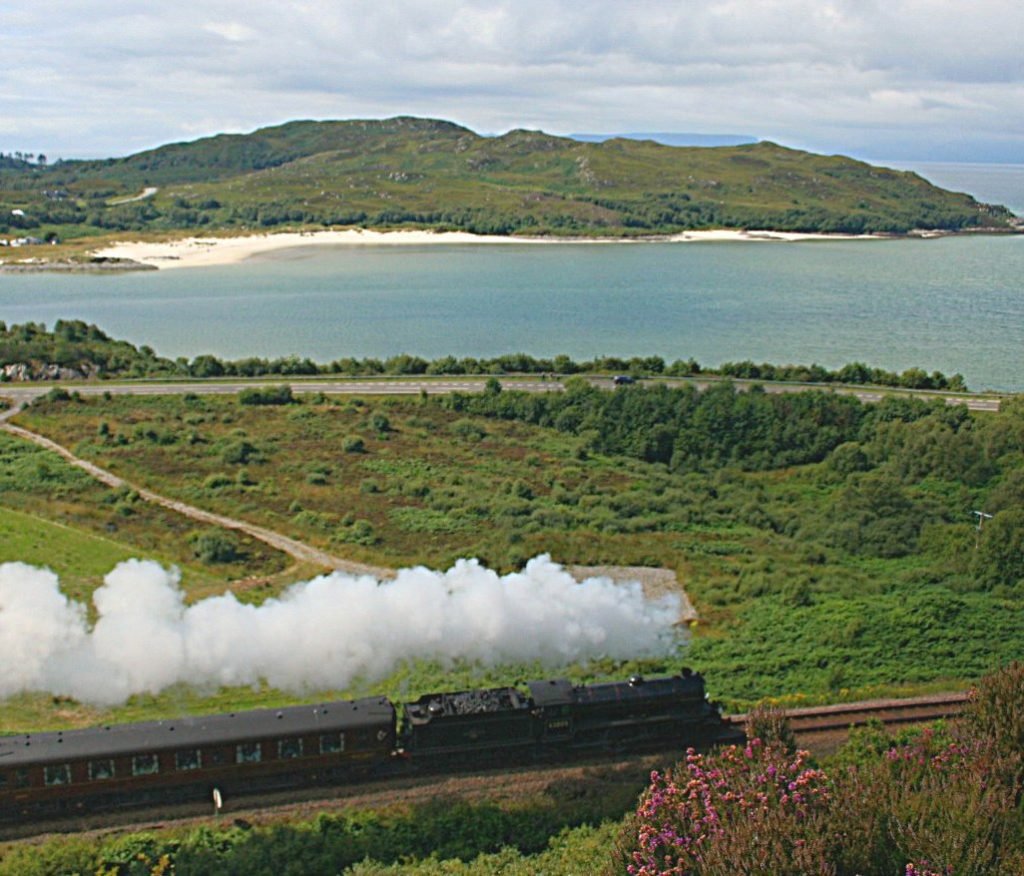
Just as I put up this page, I remembered I also had a picture of where the last two pictures above were taken from – if you see what I mean.
Here’s the headland mentioned, top right, above, taken when the tide was high and, as a bonus, the Jacobite summer steam-hauled train passing north towards Mallaig.
Stac Pollaidh
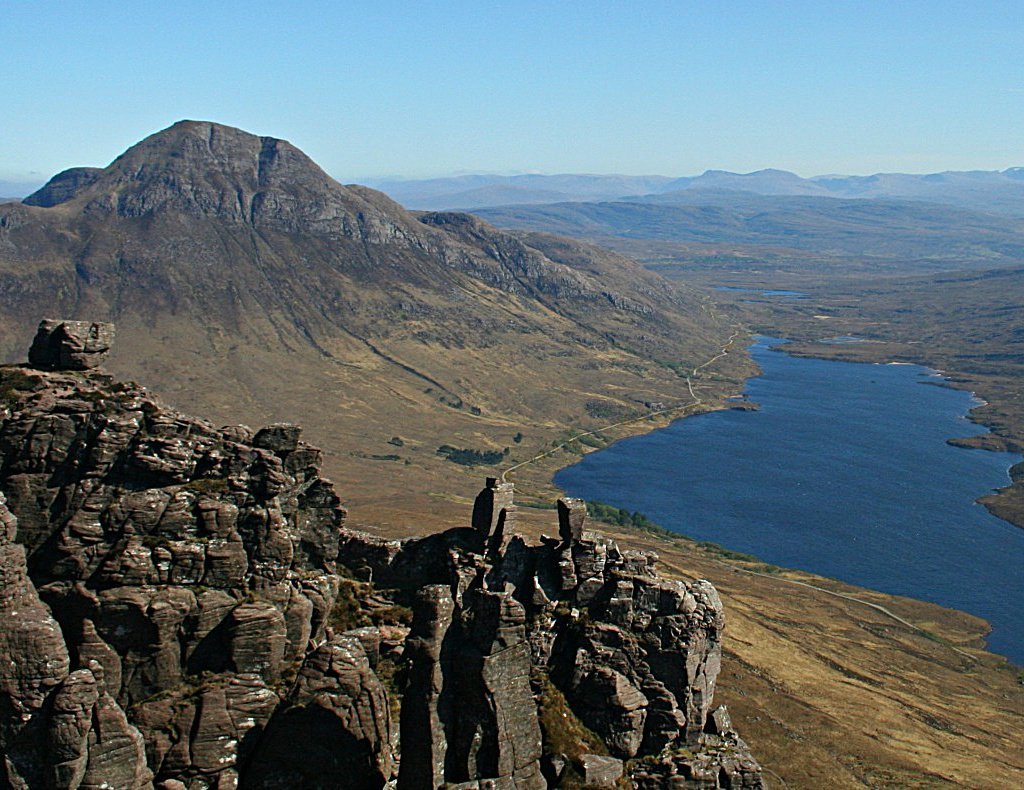
There is a whole genre of Scottish scenic pictures that are rugged, or bare and a little chilly even when the sun is shining. Or maybe that was how I was feeling when I took the picture above
The little mountain of Stac Pollaidh, on which I stand, may be small, but it’s eroding and crumbly, with lots of slightly scary rocks and pinnacles on it.
Read about the day that we went to climb Stac Pollaidh. This mini-mountain is popular with walkers but demands respect. This view is looking eastwards towards Loch Lurgainn and the only slightly bigger little mountain of Cul Beag.
…it’s a short hillwalk that’s not for the vertigo-prone!
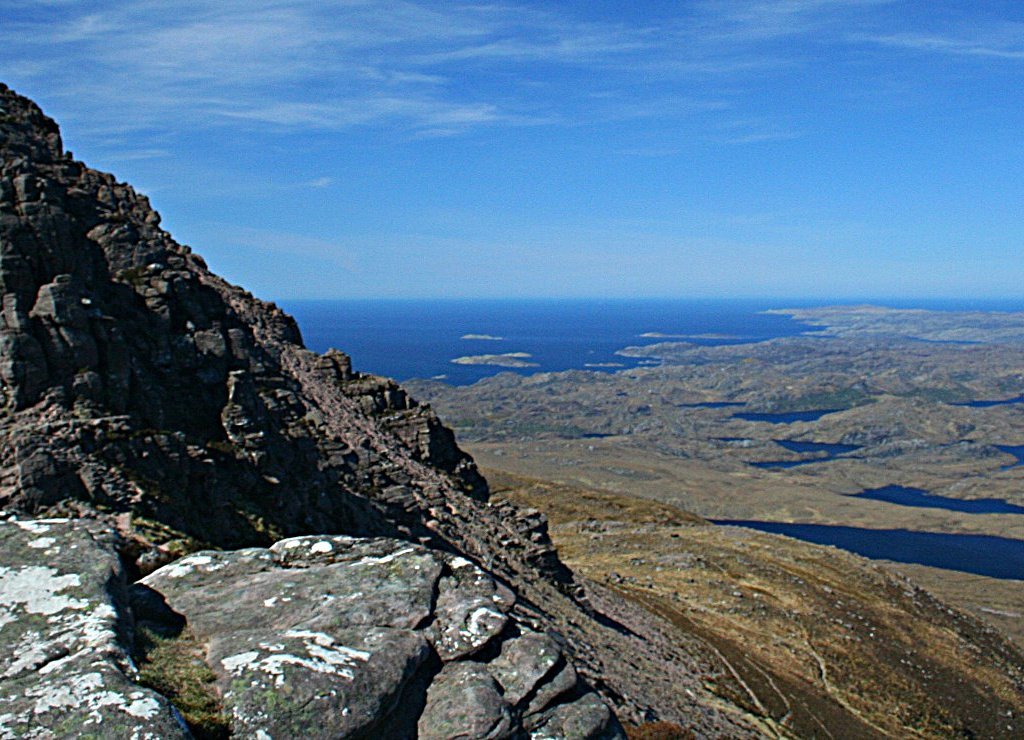
Face the other direction and you get an even better impression of these western seaboard landscapes. These peaks are sandstone, mostly, standing on a plinth of gneiss – or, more accurately, Lewissian gneiss, one of the oldest rocks in the world.
The ancient glaciers scoured out the hollows that are now interlaced lochs, while the sandstone eroded into the weird terraced profiles that characterise the Inverpolly peaks.
This in turn I believe to have launched a thousand postcards from visitors over the years, each one having been unable to resist writing: ‘having a gneiss time in Scotland.’
This is essentially a variation on that other Scottish postcard greeting, originally describing the summit of Ben Nevis: ‘missed the view but viewed the mist’. Groan.
Remember, you don’t have to go far off the beaten track for fine views.


The B862 running down the east side of Loch Ness is an old military road, built to ‘pacify’ the Highlands during the threat of the Jacobite uprisings.
It’s still in use today and it’s worth stopping off at its highest point, the Suidhe Viewpoint before rolling on past Loch Tarff and down to Fort Augustus. There are fine views towards the Great Glen.
Staying in the area, you don’t get a view of Ben Nevis, Britain’s highest mountain, from within Fort William, the bustling little town in its shadow. But you certainly do from many points to the north and west.
And these reveal its craggy north face, as in the pic above, taken near Turlundy in evening light.
Here are a few more locations where you can be creative with the views.
Hume Castle, Scottish Borders
What is this mock-ramparted castle-thing doing on this list, the learned amongst you will ask? Well, we don’t care. We think it’s the one place – other than Smailholm Tower – where you really get that rolling, blue-hill, endless view that is the essence of the Scottish Borders.
And, anyway, it’s also a reminder that scenic Scotland doesn’t always have to mean the Highlands. Wait, wait…actually, quite a lot of the time it does.

(Above) – View towards the distant Eildon Hills from Hume Castle, Scottish Borders. The Eildon Hills are mandatory in any view of the Scottish Borders. Ho-hum.
But the odd-looking tower – actually a kind of folly now – of Hume Castle is highly visible, say, from the A697, and is well worth a wee diversion, if the weather is looking clear.
Hume Castle itself, obviously, is not ‘highly visible’ in this pic however, because I am standing on it.
Glen Torridon, Wester Ross
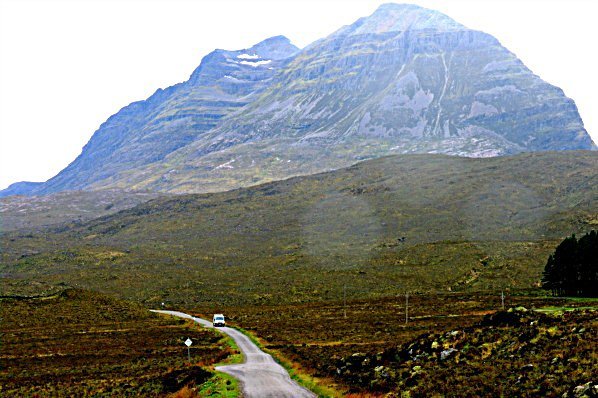
Yes, in the wee picture here of the mountain called Liathach, I expect you’ve spotted that I’d been messing about with those tempting special effects you get in fancy picture-editing apps.
That particular effect is probably not called ‘make the top of mountains unnaturally blue’ but the authentic part is the out-of-focus raindrops on the lens, right hand side.
The famous song ‘Why Does it Always Rain on Me’ actually has an answer: it is ‘because you’re probably in Glen Torridon’.
Isn’t the mountain Liathach big though?
Anyway, Sou’wester Ross, as we used to call it, is serious and austere. And lonely. And impressive. All that wild outdoorsy thing will make you think of that lovely hotel bed you will snuggle into later, perhaps.
Soaring sandstone crags, stacked one above the other in tiers. Try and see this glen when the clouds part to reveal the tops. (A long -winded way of saying, please go on a nice day.)
I’m slightly remorseful after messing with the photo, so here’s another picture of Glen (really Loch) Torridon – and it isn’t raining.

And then there is…
Glen Shiel

Glen Shiel has soaring mountains like Glen Torridon listed above, only slightly more, uhmm, alpine. At its best in late spring when there is still plenty of snow higher up.
Makes the much hyped Great Glen look tame by comparison. Honestly, I’d rather drive through here any day than face that tedious road along the Caledonian Canal.
And for something more rounded and wide-open…
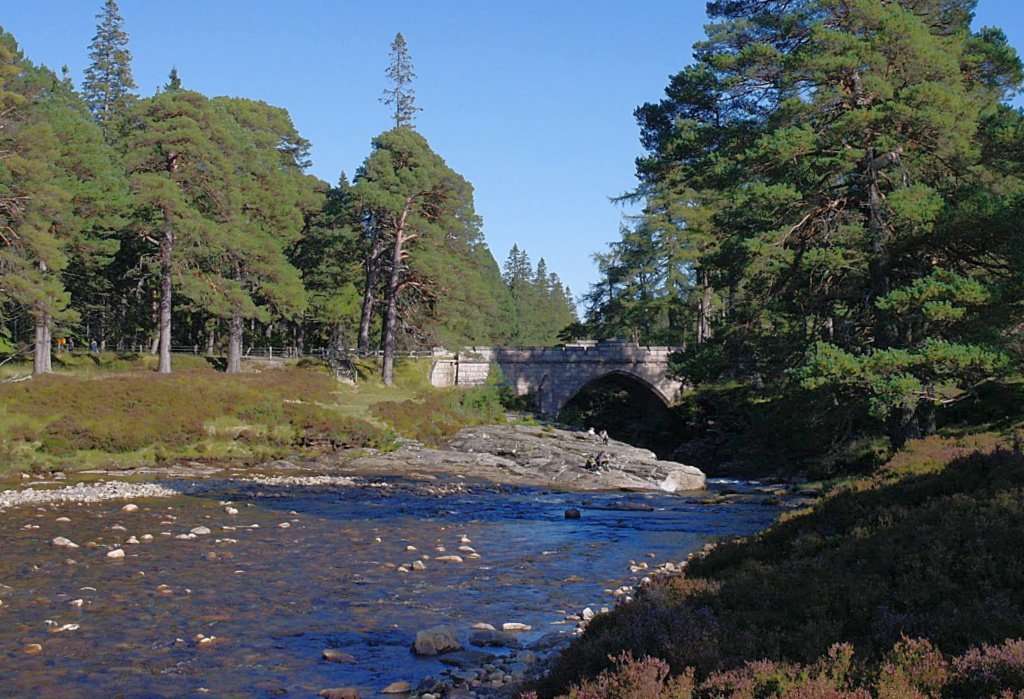
Upper Deeside, Aberdeenshire
Drive from Braemar west to the end of the road at the Linn o’ Dee. Walk a bit if time permits. The essence of pinewoody eastern Cairngorms. Not over-craggy, but plenty of ‘heathery’ atmosphere.
Walk a bit more…but take care at the Linn, where the River Dee rushes through rocky narrows.
Now for a few pictures with a cooler theme…
“When it comes to pictures of the scenery of Scotland, sometimes it isn’t the pictures that would ever make it into a conventional tourism brochure that say most about a place.
I chose the pictures you’ll see on this next section because they do, in most cases, have a cool (meteorologically speaking) feel to them. I think I might mean bleak! They sum up for me something about Scotland’s landscapes.”
Also, I couldn’t think what else to do with them.

Central Highlands Summit
(Pictured above) For example, nobody could say the picture here was a calendar shot of the scenery of Scotland, but for me the view here is the essence of the lonely, bare uplands of the Central Highlands.
This is the top of Ben Chonzie in Perthshire, late on an October day. No snow yet – except maybe just a dusting on the even higher tops of Ben Lawers range on the horizon – but the wind has turned chill.
It’s time to leave these wide and empty spaces to the odd pair of patrolling ravens. Plenty of hillwalkers will know what I mean….

East Lothian Beach
(Pictured above) A sense of space. John Muir Country Park in East Lothian from the Tynninghame end.
The little town of Dunbar is on the horizon to the east. In less than hour you can be on Princes Street in Edinburgh. But would you really want to be? The scenery of Scotland isn’t all bens and glens.

The Gleneagles Gap
(Pictured above) It’s early spring. In fact, it’s so early, I should stop pretending and just call it winter.
This pic looks north-west from the “Gleneagles Gap”, where the Ochil Hills allow one road through from the Forth Valley. It’s a direct but sometimes overlooked route from Edinburgh to the Highlands.
In this view, the famous Gleneagles Hotel is dead centre, visible as a thin pale line in the dark woodlands.
But isn’t it obvious, in the Gleneagles pic, where the real Highlands start, a little beyond?
There’s plenty of snow still on Ben Chonzie, the white plateau to the left, with Glen Turret opening beside it, below which is Glenturret Distillery at the top end of the little town of Crieff.

Moray Firth Winter
(Pictured above) Hardly a tree in sight. Just a north-facing Moray Firth coast sea-town sheltering from the winter wind and with the January sun barely lighting it.
There’s a somewhat idiosyncratic (they tell me) golf course below the cliffs, at the end of the spectacular viaduct (formerly a railway – now a walkway). The clubhouse is the white building right of centre, by the shore and left of the sea-stack.
This is the sea-town of Cullen, on the Moray Firth, north of Aberdeen, east of Inverness. The houses on the horizon are part of Portknockie, the next community to the west.

Gloomy Knoydart
(Pictured above) On the edge of the famous ‘Rough Bounds of Knoydart’, Inverie, by the shore, is reached by boat from Mallaig, on Scotland’s western seaboard.
It’s off the beaten track Scotland, but these days, paradoxically quite well known.
The picture here was taken in July. In as far as there are rugged mountains in the picture it conforms to the preconceived ideas of many visitors about the scenery of Scotland.
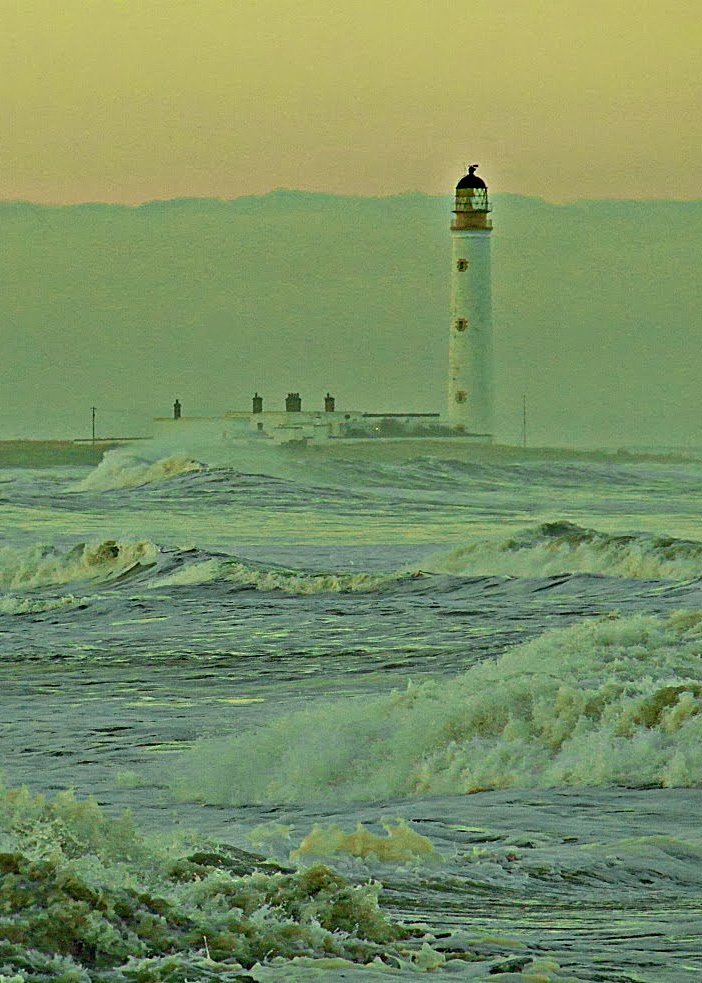
East Lothian storm surge
Here’s a storm surge and a high tide on the east coast this time – Barns Ness Lighthouse near Dunbar in East Lothian.
Dunbar and the coast beyond are well worth an excursion from Edinburgh.
Anyway, none of these pics would make it into a tourism brochure. They’re probably too honest – or, at least, not quite sunny and blue enough!
Still here, eh? Well, in this last section the common theme is: it’s a tartan and piper-free zone.
It’s more of a reminder that Scotland’s landscapes are very diverse.

(Above) Elie, a little resort town on the Fife coast. In tourism trade pictures of Scotland the sun always shines. This picture was taken in November, seconds ahead of a stinging shower of hail.
We retreated to a pub that overlooks the shore. There was a roaring fire and we had a fine lunch instead of a beach walk. It is an easy journey from here to St Andrews
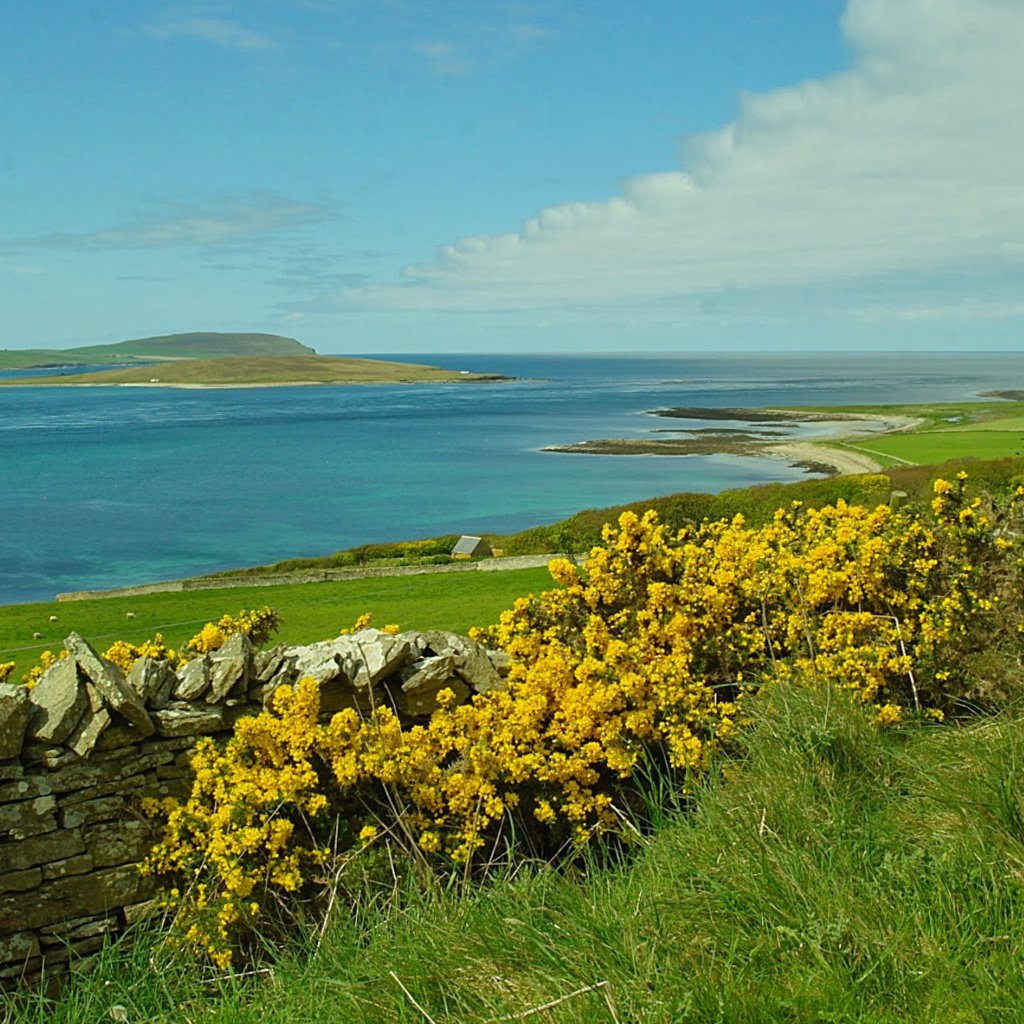
(Above.) Looking across Eynhallow Sound from Rousay, Orkney. We make no secret of our delight when we get a chance to visit Orkney.
It’s the place for different pictures of Scotland – or really, pictures of a different Scotland.
Its our cool blue northern light
There is something very beguiling abut that cool blue northern light. The vivid yellow of our hardy gorse in late spring helps the photographer as well.
This is taken from the island of Rousay, (from Norse ‘Rolf’s island’) looking across Eynhallow Sound to Mainland (what they call the main island of Orkney).
You can day-trip Rousay if you are staying on Mainland. There are regular ferry services.
Down by the shore is the extraordinary Neolithic complex of Midhowe – covered in our Rousay page.

(Above) View north across Rannoch Moor from the summit of Beinn Achaladair, one of Scotland’s Munros.
Quite high in the picture, in a line upwards from the little dog’s head, is the main road across the Moor, heading for Glen Coe and eventually Fort William.
And above that, in the centre, the largest mountain on the horizon is Ben Nevis, the highest in Scotland.
No, I don’t know what our old dog Millie is thinking as she contemplates the open reaches of Rannoch Moor, almost 3000ft (914m) below her.
(In fact, I feel a caption competition coming on…)
She’s probably enjoying the coolness of the snow-bank though. Yes, I’ve probably used this pic elsewhere on the site. But it’s my all-time favourite. Indulge me, will ya?
Rannoch Moor was the setting for the famous chase scene in ‘Kidnapped’ by Robert Louis Stevenson. (More Rannoch pictures on that page too.)

(Above) Looking south over Loch Tay from a point a few miles to the east of Killin. Scotland is the place for dramatic light effects. But you have to be quick. That little patch of weak autumn sunshine will roll on fast.
Just take care how you park if you are trying to catch these fleeting effects!
Classic Highland Perthshire: some pasture by the loch-side, but it quickly runs up to marginal high ground. This is near Ben Lawers with its ‘base-rich’ rocks – so it’s a bit more lush than other grazings hereabouts.
An autumn tour of Scotland has plenty to offer the picture-taker.